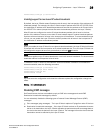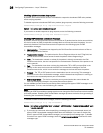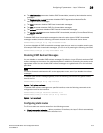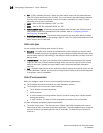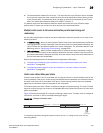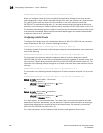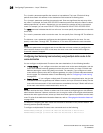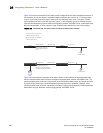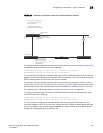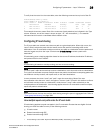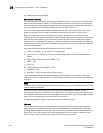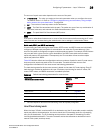
PowerConnect B-Series FCX Configuration Guide 825
53-1002266-01
Configuring IP parameters – Layer 3 Switches
26
The commands in the previous example configure two static IP routes. The routes go to different
next-hop gateways but have the same metrics. These commands use the default metric value (1),
so the metric is not specified. These static routes are used for load sharing among the next-hop
gateways.
The following commands configure static IP routes to the same destination, but with different
metrics. The route with the lowest metric is used by default. The other routes are backups in case
the first route becomes unavailable. The Layer 3 Switch uses the route with the lowest metric if the
route is available.
PowerConnect(config)# ip route 192.128.2.69 255.255.255.0 209.157.22.1
PowerConnect(config)# ip route 192.128.2.69 255.255.255.0 192.111.10.1 2
PowerConnect(config)# ip route 192.128.2.69 255.255.255.0 201.1.1.1 3
In this example, each static route has a different metric. The metric is not specified for the first
route, so the default (1) is used. A metric is specified for the second and third static IP routes. The
second route has a metric of two and the third route has a metric of 3. Thus, the second route is
used only of the first route (which has a metric of 1) becomes unavailable. Likewise, the third route
is used only if the first and second routes (which have lower metrics) are both unavailable.
For complete syntax information, refer to “Configuring a static IP route” on page 822.
Configuring standard static IP routes and interface or null static routes to the
same destination
You can configure a null0 or interface-based static route to a destination and also configure a
normal static route to the same destination, so long as the route metrics are different.
When the Layer 3 Switch has multiple routes to the same destination, the Layer 3 Switch always
prefers the route with the lowest metric. Generally, when you configure a static route to a
destination network, you assign the route a low metric so that the Layer 3 Switch prefers the static
route over other routes to the destination.
This feature is especially useful for the following configurations. These are not the only allowed
configurations but they are typical uses of this enhancement:
• When you want to ensure that if a given destination network is unavailable, the Layer 3 Switch
drops (forwards to the null interface) traffic for that network instead of using alternate paths to
route the traffic. In this case, assign the normal static route to the destination network a lower
metric than the null route.
• When you want to use a specific interface by default to route traffic to a given destination
network, but want to allow the Layer 3 Switch to use other interfaces to reach the destination
network if the path that uses the default interface becomes unavailable. In this case, give the
interface route a lower metric than the normal static route.
NOTE
You cannot add a null or interface-based static route to a network if there is already a static route of
any type with the same metric you specify for the null or interface-based route.



